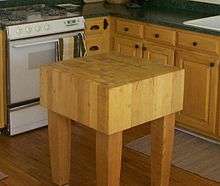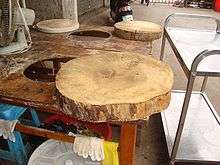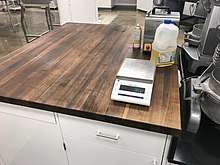Butcher block
Butcher block, butcher's block is a style of assembled wood (often hard maple, teak, birch, or walnut) used as heavy duty chopping blocks, table tops, and cutting boards.[1] It was commonly used in butcher shops and meat processing plants but has now become popular in home use.[2][3]


There are two basic styles of butcher block: end grain and edge grain.[2]
Butcher blocks have been used in butcher shops for centuries, and still are in many European countries. Increasingly, though, butcher block is being used in domestic kitchens as an alternative to stone and laminate countertops. This has created a new industry in the kitchen design arena and many furniture manufacturers and hardwood flooring companies are getting into the production of butcher blocks and butcher block countertops, in part because the countertops can be constructed from left-over wood that would otherwise be discarded.
Basic care
Proper care of a butcher block is important for longevity of the material and, to a degree, food safety.

If the material is regularly exposed to water and not well cleaned, then mold can form. The seams where the wood is joined can buckle as the wood expands and contracts. Keeping the material well oiled allows it to maintain a rich color and its water repelling properties. [4]
To properly care for the butcher block any foreign material should first be removed, it can be disinfected with vinegar (or in extreme cases, bleach), allowed to dry well, and refreshed with mineral oil or other food safe sealant[5]
References
- Old-House Journal 09 1992, pg.38
- "Butcher Block Terms". Archived from the original on September 2, 2012. Retrieved October 4, 2012.
- "Oxford English Dictionary: butcher's block". Retrieved October 5, 2012.
- "Butcher Block Countertops: 6 Pros and Cons". Retrieved December 26, 2017.
- "How to Clean and Care for Your Butcher Block". Retrieved December 26, 2017.